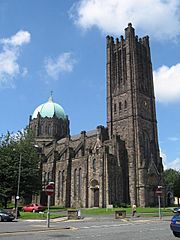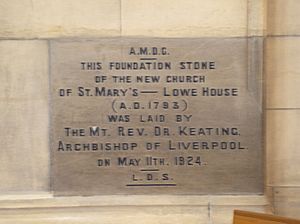Church of St Mary, Lowe House facts for kids
Quick facts for kids Church of St Mary, Lowe House |
|
|---|---|

South side of the church
|
|
| 53°27′26″N 2°44′25″W / 53.4571°N 2.7404°W | |
| OS grid reference | SJ5093595844 |
| Location | St Helens, Merseyside |
| Country | United Kingdom |
| Denomination | Roman Catholic |
| Website | stmaryslowehouse.org |
| History | |
| Status | Active |
| Founded | 1924 |
| Architecture | |
| Functional status | Parish church |
| Heritage designation | Grade II listed |
| Designated | 11 September 1951 |
| Architect(s) | Charles B. Powell |
| Administration | |
| Parish | St Mary's and St. Thomas of Canterbury |
| Deanery | St Helens – St Monica Pastoral Area |
| Archdiocese | Liverpool |
| Province | Liverpool (aka Northern) |
The Church of St Mary, Lowe House is a Roman Catholic church located on North Road in St Helens, Merseyside. This church was built starting in 1924. It was looked after by the Society of Jesus (also known as the Jesuits) until 1981. The building is special because it is a Grade II listed building. This means it is an important historical building. It has a mix of Romanesque and Gothic styles.
Contents
History of St Mary's Church
How the Church Began
The church is called St Mary's Lowe House because it was built on land given by Winefred Eccleston. Her maiden name was Lowe. The land was close to her home on Cowley Hill. Winefred's husband, John Gorsuch Eccleston, used to own Eccleston Hall. This hall had a Catholic chapel, but later owners closed it.
So, the first chapel was built and opened in 1793. It became known as Lowe House. This first chapel was made bigger three times. The last time it was expanded was in 1857.
Building the New Church
More and more Catholic people were moving to the town. Because of this, a new, larger church was needed. Construction of the new church began in 1924. It was built next to the original chapel. The old chapel was later taken down in 1930.
The first stone for the new church was laid on May 11, 1924. This was done by Frederick Keating, who was the Archbishop of Liverpool. Father Reginald Riley SJ decided the church should be very large. He wanted it to serve the growing Catholic community. Father Riley was the parish priest from 1912 to 1946.
The church officially opened in 1929. It was designed by Charles B. Powell, an architect from Ireland. He also designed other buildings for the Jesuits in Dublin. People in St Helens sometimes call it 'The Basilica of St Helens'. They also call it 'The Poor Man's Cathedral'. This is because local people donated money to build it. They did this during a time when many people were struggling financially.
Church Design and Features
The church has a special dome. It mixes Romanesque and Gothic styles. The dome sits where the main part of the church (nave), the altar area (sanctuary), and the side sections (transepts) meet. It rests on an octagonal tower that looks like a castle.
On top of the dome is a copper cross. This cross is 16 feet tall. A local builder's family, James Yearsley, gave it to the church. His company helped build the church's foundations. The church also has a tall tower, which is 130 feet high. On this tower, there is a clock face. It is surrounded by shiny gold mosaic.
The Carillon Bells
What is a Carillon?
A very important part of the clock tower is its historic Carillon. A carillon is a set of bells that can be played like a musical instrument. Instead of just ringing bells one by one with ropes, a carillon has a keyboard. A musician can play melodies and harmonies on these bells.
Carillon at St Mary's
The carillon at St Mary's was made by John Taylor & Co. of Loughborough. They are famous bell makers. This carillon is the largest in the North West of England. It has 47 bells! The carillon is played regularly. Sometimes, musicians who specialize in playing carillons visit and give concerts.
Church Parish and Services
Weekly Mass and Changes
Every week, the church holds Mass on Sunday mornings. It starts at 11:00 am.
In 1980, the leader of the Jesuits in Britain made an announcement. He told the church members that the Jesuits would no longer run the church after Easter 1981. The church was then given to the Archdiocese of Liverpool.
In 2010, St Mary's parish joined with another nearby parish. This was the Holy Cross and St Helen parish in the center of St Helens. They became one parish called Holy Cross and St Mary. However, things changed again in 2014. St Mary's Lowe House was then paired with the parish of St Thomas of Canterbury, Dentons Green. The Holy Cross & St. Helen church went back to being a single parish with a new priest.
Gallery
See also
- Listed buildings in St Helens, Merseyside
- List of carillons of the British Isles
- 1888–1913 Overlay OS Map via National Library of Scotland showing positions of the old and present churches






